Emanuel Lottem, left, and Sheldon Teitelbaum. (photo by Roni Sofer)
After four years of hard work, Sheldon Teitelbaum and Emanuel Lottem have completed the first instalment of Zion’s Fiction: A Treasure of Israeli Speculative Literature.
Today, Montreal-born Teitelbaum lives with his family in Los Angeles, but, before that, he lived in Israel for many years – starting with five years in the Israeli army, a period of service that included the 1982 Lebanon War.
“I lived to tell the tale and, when I came back, I received an offer from some local magazines and newspapers, including the Jewish Post & News [in Winnipeg], to write pieces for them, which I accepted, in addition to working on the night desk as a sub-editor,” Teitelbaum told the Independent.
Then, he was hired by the Weizmann Institute of Science as a writer, which he did for a couple of years before moving with his family to California. There, he began writing for the Los Angeles Times, as well as writing a number of articles for the New York Times, Wired, Entertainment Weekly and other publications, while also working at University of Southern California as a science writer.
About Zion’s Fiction, Teitelbaum said, “It is not a book of my stories. I have absolutely no apparent talent in writing stories. But, I have been involved in Israeli science fiction and have been reading it for 40 years. And, it occurred to me at a certain point that the local (Israeli) fiction had reached a level of confidence that merited the attention of the world. As a result, I called up my partner, Emanuel Lottem, who is Israel’s premier interpreter, translator actually, of science fiction … and, I Skyped him and said, ‘You know, I just want to lay down two words to you – Zion’s fiction.’ Apparently, his jaw dropped. It just says the whole story.”
Teitelbaum contacted science fiction grandmaster Robert Silverberg, who he has interviewed in the past, and pitched the idea. Silverberg was hooked and agreed to provide a foreword and to connect them with agent Eddie Schneider of JABberwocky Literary Agency in New York.
As it turned out, publishing houses were not interested and, if not for the last publishing house on their list, they would have had to wait even longer to see their idea in print.
Once they had a publishing house, next came the difficult task of determining what would go into the book.
“We actually had twice as many stories than we needed,” said Teitelbaum. “We decided to save them for the next volume. However, we had a book launching at the Israeli Science Fiction convention in September, and we met with the head of the Israeli Society for Fantasy and Science Fiction. In conjunction with them, we’d publish their newly released volume – a collection of the best of the best of the Geffen winners of the last 17 years.”
(The Geffen Awards are named after the late Amos Geffen, one of the first editors and translators of science fiction in Israel.)
“As you might know,” continued Teitelbaum, “translation is a hideously expensive engagement. And they were gracious enough to take on the initial translation with Emanuel, and I was ready to hunker down with the actual line editing.”
All 16 stories that were selected for the first volume of Zion’s Fiction have received positive reviews worldwide. They are very different from the kind of speculative fiction people read in the West, according to Teitelbaum.
For most Israelis, when it comes to science fiction, Teitelbaum said, “It’s a thing that’s extremely fragile – more fragile than you’d find anywhere else in the world … because, when Hezbollah bombs starts flying, everyone’s nose is to the ground … and there ain’t no room for the fantasy.
“Not to mention that Israel is situated at a crossroads fortress called Megiddo, which the Greeks gave the name Armageddon, which is a lodestone for apocalyptic worry and fretting all over the world … and especially in Israel, [where] nobody does a better job of trying to put off disaster by writing about it.”
The Israeli science fiction that is broadly popular is that which deals with near-future developments in society, with specific connections to what is going on politically.
In terms of readership, Teitelbaum feels Zion’s Fiction will appeal to academics, noting, “There are several Jewish studies programs in North America and Europe [interested]. As someone who volunteers at the local high school my kids went to, teaching science fiction as a course for senior English, I know that, if you want to get kids to read, this is one of the ways to do it.
“I also know that Introduction to Science Fiction in undergraduate classes has upwards of 600 people, and I’d hope this series would ultimately provide academics with a reason to fashion courses on the subject of the Israeli fantastique.”
Teitelbaum also thinks that Zion’s Fiction could serve as an excellent gift for anyone with a soft spot for Israel or an interest in Israeli writing, or for science fiction lovers wanting to explore a unique segment in the genre.
“Unlike American Jewish science fiction, which hits you over the head with issues of religion and intermarriage and, you know, all of the shtetl nonsense, Israeli science fiction is a lot more subtle,” said Teitelbaum. “It doesn’t deal with the Holocaust directly in most instances, although you can see that it’s an underlying theme.
“It takes place in the near future, rather than the far. It’s a little more realistic than you would find in American science fiction. It doesn’t concern itself with Jewish folklore from the old country. It wears its Israeliness easily. Its Israeli characters are identifiable as Israelis.”
Zion’s Fiction is widely available and has already been translated for sale in countries such as Japan, Korea and Russia, with interest expressed in Turkey and Germany. For more information, visit zionsfiction.com. To order the book, go to amazon.com.
Rebeca Kuropatwa is a Winnipeg freelance writer.


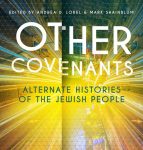
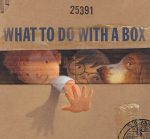
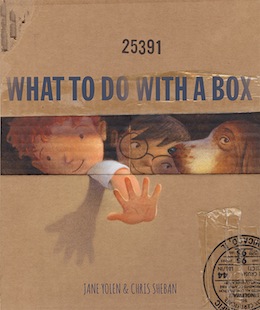 The beautifully and creatively illustrated What to do with a Box (Creative Editions, 2016) features the rhythmic writing of Jane Yolen and the inspired art of Chris Sheban. The book is a tribute to the power of the imagination – a way to impart to the younger set that fun doesn’t necessarily need batteries. It’s also a reminder to parents that expensive toys aren’t at the root of what makes playtime enjoyable, and they may even be enticed to join their kids in a cardboard box adventure – if they’re invited to come along, that is.
The beautifully and creatively illustrated What to do with a Box (Creative Editions, 2016) features the rhythmic writing of Jane Yolen and the inspired art of Chris Sheban. The book is a tribute to the power of the imagination – a way to impart to the younger set that fun doesn’t necessarily need batteries. It’s also a reminder to parents that expensive toys aren’t at the root of what makes playtime enjoyable, and they may even be enticed to join their kids in a cardboard box adventure – if they’re invited to come along, that is.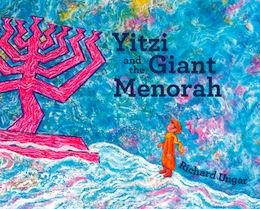 For slightly older readers (or listeners), Richard Unger has written and illustrated a more traditional story with Chagallesque art, Yitzi and the Giant Menorah (Penguin Random House, 2016). It is a picture book, but with a substantive amount of text on each page. It, too, is beautifully and creatively put together, with most of the text printed on a plain page that includes a black-and-white sketch that doesn’t overlap it in any way, making the reading easier. More importantly, it leaves most of the colorful, vibrant and expressive artwork on the opposite page free from writing. At the end of the book is the brief story of Chanukah.
For slightly older readers (or listeners), Richard Unger has written and illustrated a more traditional story with Chagallesque art, Yitzi and the Giant Menorah (Penguin Random House, 2016). It is a picture book, but with a substantive amount of text on each page. It, too, is beautifully and creatively put together, with most of the text printed on a plain page that includes a black-and-white sketch that doesn’t overlap it in any way, making the reading easier. More importantly, it leaves most of the colorful, vibrant and expressive artwork on the opposite page free from writing. At the end of the book is the brief story of Chanukah.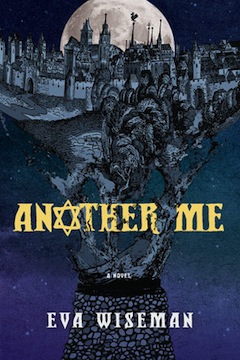 Eva Wiseman’s Another Me (Tundra Books, 2016) is set in the mid-1300s in Strasbourg, France. It starts with the main character’s death at the hands of the men poisoning the town’s water – an act the Jews were accused of committing not only in Strasbourg, but other cities in Europe, as well. It was thought that poisoned water was causing the plague and, since fewer Jews were dying, the rumors began that they were causing the illness. In reality, Jews were also dying, but in fewer numbers because Jewish law required much more handwashing than was customary in medieval times.
Eva Wiseman’s Another Me (Tundra Books, 2016) is set in the mid-1300s in Strasbourg, France. It starts with the main character’s death at the hands of the men poisoning the town’s water – an act the Jews were accused of committing not only in Strasbourg, but other cities in Europe, as well. It was thought that poisoned water was causing the plague and, since fewer Jews were dying, the rumors began that they were causing the illness. In reality, Jews were also dying, but in fewer numbers because Jewish law required much more handwashing than was customary in medieval times.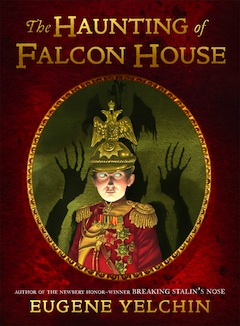 Magic – or, at least, ghosts – also informs the storytelling in Eugene Yelchin’s The Haunting of Falcon House (Henry Holt and Co., 2016).
Magic – or, at least, ghosts – also informs the storytelling in Eugene Yelchin’s The Haunting of Falcon House (Henry Holt and Co., 2016). Jane Yolen’s Briar Rose: A Novel of the Holocaust (Tor Teen, 2016) is also a retelling – an adaptation of Sleeping Beauty. And, it is a reissue, having originally been published almost 15 years ago in a series created by Terri Windling, which comprised novels by various authors that reinterpreted classic fairy tales.
Jane Yolen’s Briar Rose: A Novel of the Holocaust (Tor Teen, 2016) is also a retelling – an adaptation of Sleeping Beauty. And, it is a reissue, having originally been published almost 15 years ago in a series created by Terri Windling, which comprised novels by various authors that reinterpreted classic fairy tales.
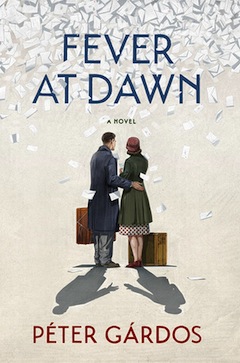
 Two-Gun & Sun (Caitlin Press Inc., 2015) might also make a good film. It brings to mind Joss Whedon’s Firefly, mixing science fiction (specifically steampunk) with opera’s larger-than-life and often unbelievable drama with history. It’s a very stylized novel, which, more than other books, means that it will be loved by some readers, and not so much by others.
Two-Gun & Sun (Caitlin Press Inc., 2015) might also make a good film. It brings to mind Joss Whedon’s Firefly, mixing science fiction (specifically steampunk) with opera’s larger-than-life and often unbelievable drama with history. It’s a very stylized novel, which, more than other books, means that it will be loved by some readers, and not so much by others.